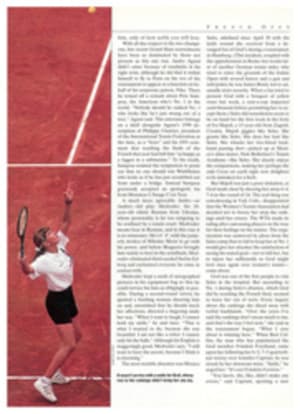
The Day the Bambino Bombed
Silas Johnson goes into his windup. These days the leg kick isn't quite as high, nor is the fastball as nasty, as it once was; the pitching mound is his dining-room rug. But Johnson looks pretty good for 86. He's recounting a ball game that took place 58 years ago in Cincinnati, one that in the grand scheme of things was just another Reds-Boston Braves game. But for Johnson, May 26, 1935, was the shining moment of a 17-year major league career. That was the day he struck out Babe Ruth three times.
Ruth, finishing out his career with the Braves, had smacked three homers the day before against the Pittsburgh Pirates, and fans were hoping that he had some more life left in his big bat. Now it was Babe Ruth Day in Crosley Field, but the Sultan of Swat succumbed once, twice, three times—twice swinging—in a 6-3 complete-game win for Johnson. Four days later Ruth came to bat for the last time, grounding out in the top of the first inning against Philadelphia. He left the game because of a sore knee and retired from baseball shortly afterward.
Over the years a legend grew, and Si Johnson of Sheridan, Ill., became known as the guy who pushed Ruth into retirement with his three K's. But Johnson says that's ridiculous. "Babe was on his way out by then," he says, nodding toward a painting of Ruth that hangs in his dining room and offering his best imitation of Ruth's batting stance. "He was practically washed up, the poor guy. Those pitches were all fastballs down the middle. People came to see the Babe hit the ball, but he was late on every swing. Don't tell anybody, but I was hoping the Babe would hit one out. He was a hell of a swell fella."
If Ruth was born for baseball greatness, Johnson seemed destined for the plow. But though his father worked on a farm in Danway, Ill., Johnson had other plans. "I'd be playing catch with my dad by the windmill, and I'd tell him there had to be an easier way to make a living than working from dark to dark for $20 a month," he says. In 1928 Johnson attended a try-out camp in Rock Island, Ill., with 81 other hopefuls. He was the only pitcher chosen, and he went on to win 11 straight games in the Mississippi Valley League. Near the end of the season, his contract was purchased by the Reds.
His first at bat was against Grover Cleveland Alexander of the St. Louis Cardinals. "I got a base hit and I thought, Boy, this is fine," he says. "But I never hit my weight in my life." Johnson, 5'11½", who pitched at 185, had a career .123 batting average.
Johnson retired in 1947 with a 101-165 record, pitching for mostly second-rate clubs. He pitched two one-hitters in 1933, made Opening Day starts five years in a row ("I lost 'em all, too") and roomed with Dizzy Dean when he was a member of the St. Louis Cardinals' Gashouse Gang. After coaching for four years, he left baseball in 1950 and went to work as an engineer at the Sheridan Correctional Center.
Each week Johnson gets 40 or 50 letters requesting his autograph. He answers every letter, and he spends $1,000 a year getting his picture printed. He also goes to 10 to 15 baseball-card shows a year, and he refuses to charge for autographs.
Johnson's friend and Sheridan's former mayor, Al Rucker, says Johnson is a genuine hero in the town he has lived in for 57 years. "We needed a doctor in Sheridan a few years ago, and we were raising money to build a medical center. Si was the first one in line to help, with a check for $1,000," he says. "He means a lot to the people in this town, especially the kids. The Babe Ruth name is magical, and Si has a connection."
Johnson, whose wife, Doris, died in 1986, still works with local Little Leaguers and speaks to Boy Scouts. Everywhere he goes, people want to talk about Ruth. Johnson will look out his bedroom window and see four or five kids on their bicycles, sitting in front of his house. "All the local kids want to talk about the great Babe Ruth," he says. "They ask me things like, 'Did the Babe get mad when you struck him out?' I tell them no, that the Babe was a true gentleman. 'Did the Babe run around at night?' If he did, I wouldn't tell the kids."
Ruth signed one of the three strikeout balls for Johnson, but it was stolen from his living room during a holiday party years ago. "That hurt, but I've still got the memories as though it happened yesterday," he says. "It's been fun over the years. How many other ballplayers out there can say they struck out the greatest hitter who ever lived, not once but three times in one game?"
PHOTO
COURTESY OF SILAS K. JOHNSON
Johnson played for four teams in a 17-year career.
Mark Mandernach is a free-lance journalist who lives in Arlington Heights, Ill.

